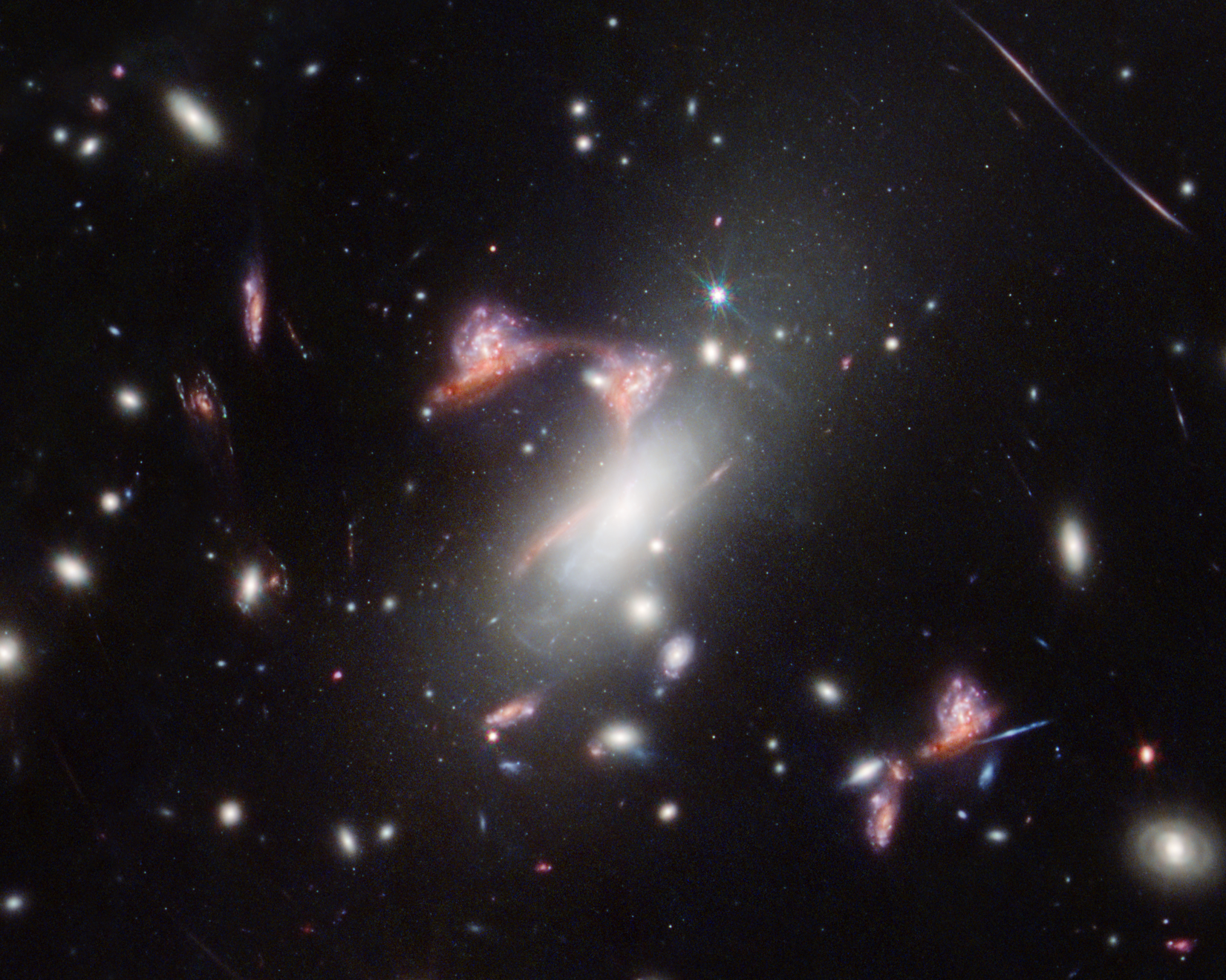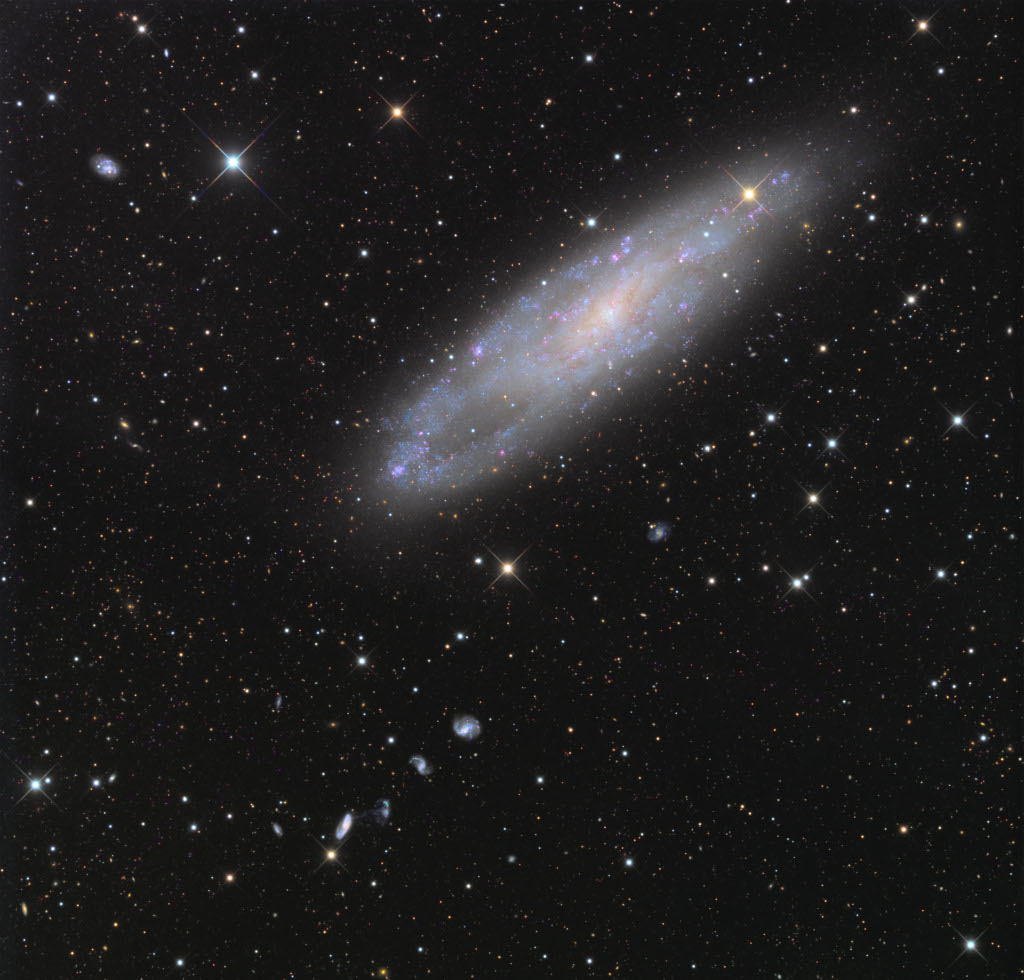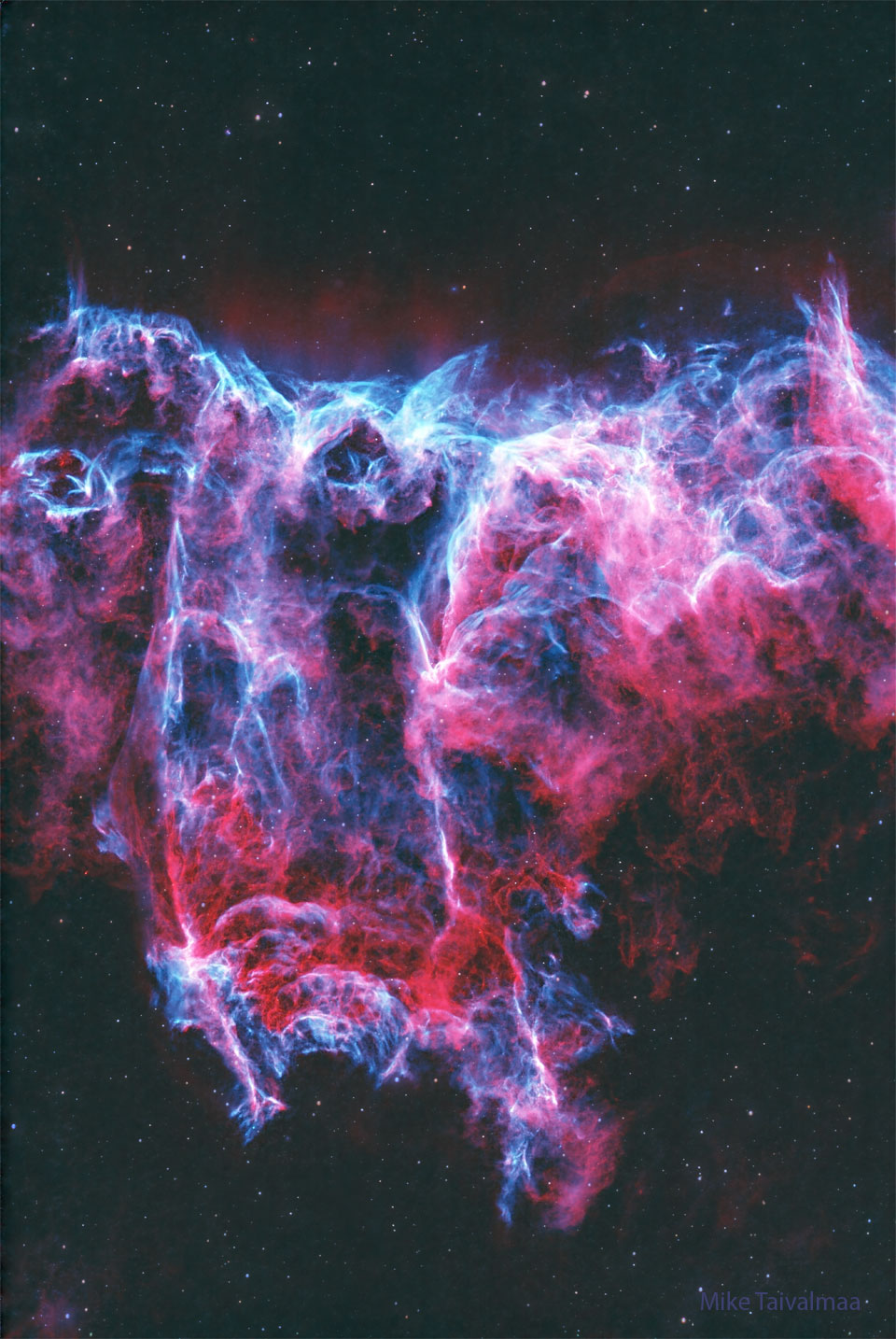Blog
The galaxy cluster MACS-J0417.5-1154 is so massive it is warping the fabric of space-time and distorting the appearance of galaxies behind it, an effect known as gravitational lensing. This natural phenomenon magnifies distant galaxies and can also make them appear in an image multiple times, as NASA’s James Webb Space Telescope saw here. Two distant, interacting galaxies — a face-on spiral and a dusty red galaxy seen from the side — appear multiple times, tracing a familiar shape across the sky. Active star formation, and the face-on galaxy’s remarkably intact spiral shape, indicate that these galaxies’ interaction is just beginning. Astronomers used both telescopes to observe the galaxy cluster MACS-J0417.5-1154, which acts like a magnifying glass because the cluster is so massive it warps the fabric of space-time. This allows astronomers to see enhanced detail in much more distant galaxies behind the cluster. However, the same gravitational effects that magnify the galaxies also cause distortion, resulting in galaxies that appear smeared across the sky in arcs and even appear multiple times. These optical illusions in space are called gravitational lensing. 4.65 Bly distant!

George Roger Waters (born 6 September 1943) is an English musician and singer-songwriter. In 1965, he co-founded the rock band Pink Floyd as the bassist. Following the departure of the songwriter, Syd Barrett, in 1968, Waters became Pink Floyd’s lyricist, co-lead vocalist and conceptual leader until his departure in 1985.
Pink Floyd achieved international success with the concept albums The Dark Side of the Moon (1973), Wish You Were Here (1975), Animals (1977), The Wall (1979), and The Final Cut (1983). By the early 1980s, they had become one of the most acclaimed and commercially successful groups in popular music. Amid creative differences, Waters left in 1985 and began a legal dispute over the use of the band’s name and material. They settled out of court in 1987. Waters’s solo work includes the studio albums The Pros and Cons of Hitch Hiking (1984), Radio K.A.O.S. (1987), Amused to Death (1992), and Is This the Life We Really Want? (2017). In 2005, he released Ça Ira, an opera translated from Étienne and Nadine Roda-Gils’ libretto about the French Revolution.
In 1990, Waters staged one of the largest rock concerts in history, The Wall – Live in Berlin, with an attendance of 450,000. As a member of Pink Floyd, he was inducted into the US Rock and Roll Hall of Fame in 1996 and the UK Music Hall of Fame in 2005. Later in 2005, he reunited with Pink Floyd for the Live 8 global awareness event, their only appearance with Waters since 1981. He has toured extensively as a solo act since 1999. He performed The Dark Side of the Moon for his world tour of 2006–2008, and The Wall Live, his tour of 2010–2013, was the highest-grossing tour by a solo artist at the time.
Waters incorporates political themes in his work and is a prominent supporter of Palestine in the Israeli–Palestinian conflict. He has called for the removal of the Israeli West Bank Barrier, supports the Boycott, Divestment and Sanctions movement against Israel, and describes Israel’s treatment of Palestinians as apartheid. Some of his comments, such as his likening of Israel to Nazi Germany, and elements of his live shows, drew accusations of antisemitism, which Waters dismissed as a conflation of anti-Semitism with anti-Zionism.
more...Edward Lozano Duran (September 6, 1925 – November 22, 2019) was an American jazz guitarist from San Francisco. He recorded often with Vince Guaraldi and was a member of the Benny Goodman orchestra during the 1970s.
Duran started on piano at age seven and switched to guitar at 12. By fifteen he was performing professionally with jazz musicians who visited San Francisco in the 1940s and 1950s. He was in a trio with his brothers, Carlos Duran and Manny Duran, from 1948 to 1952. Beginning in the 1950s, he worked in San Francisco with Chet Baker, Charlie Parker, Red Norvo, George Shearing, and Flip Phillips.
Around 1957, Duran was the guitarist in the CBS Radio Orchestra under the direction of Ray Hackett for the Bill Weaver Show, a variety show broadcast by CBS’s San Francisco affiliate, KQW, later renamed KCBS, from the Palace Hotel. While playing with the CBS Orchestra, Duran met Brunell and performed on her debut album, Intro to Jazz of the Italian-American. The album was recorded by San Francisco Jazz Records, a short-lived label that was part of the production of the radio station.
In 1954, his friend, Vince Guaraldi, who had been playing with Cal Tjader, started a trio with Duran and bassist Dean Riley. Guaraldi introduced Tjader to Duran and his two brothers. All three Duran brothers were members of Cal Tjader’s Mambo Quintet in the mid 1950s.
more...Charles Moffett (September 6, 1929 – February 14, 1997) was an American free jazzdrummer.
Moffett was born in Fort Worth, Texas, where he attended I.M. Terrell High School with Ornette Coleman. Before switching to drums, Moffett began his musical career as a trumpeter. At the age of 13, he played trumpet with Jimmy Witherspoon, and later formed a band, the Jam Jivers, with fellow students Coleman and Prince Lasha. After switching to drums, Moffett briefly performed with Little Richard.
Moffett served in the United States Navy, after which he pursued boxing before studying music at Huston-Tillotson College in Austin. Moffett married in 1953 (Coleman was best man, and performed at the wedding), then began teaching music at a public school in Rosenberg, Texas
In 1961, Moffett moved to New York City to work with Ornette Coleman, but the saxophonist soon went into a brief retirement period. Moffett worked with Sonny Rollins, appeared on Archie Shepp‘s album Four for Trane, and led a group that included Pharoah Sanders and Carla Bley. When Coleman returned to performing in 1964, he formed a trio with Moffett and bassist David Izenzon. Moffett also performed on vibraphone.
more...Mathis James Reed (September 6, 1925 – August 29, 1976) was an American bluesmusician and songwriter. His particular style of electric blues was popular with a wide variety of audiences. Reed’s songs such as “Honest I Do” (1957), “Baby What You Want Me to Do” (1960), “Big Boss Man” (1961), and “Bright Lights, Big City” (1961) appeared on both Billboard magazine’s R&B and Hot 100 singles charts.
Reed influenced many other musicians, including Elvis Presley, Hank Williams Jr., and the Rolling Stones, who recorded his songs. Music critic Cub Koda describes him as “perhaps the most influential bluesman of all,” due to his easily accessible style.bReed was born in Dunleith, Mississippi. He learned the harmonica and guitar from his friend Eddie Taylor. After several years of busking and performing there, he moved to Chicago, Illinois, in 1943.
more...There are two types of Rondeñas: the song, which is a Fandango associated with the city of Ronda, and the solo guitar form, created by Ramón Montoya. The song has the same three-count compás as the other rhythmic forms based on the Verdiales. The solo guitar piece is a toque libre with no fixed rhythmic pulse. The primary feature that distinguishes the Rondeñas from other Fandango forms is the melody. As with other Verdiales-based forms, the guitar introduction and interludes are in the phrygian mode, while the lines of verses themselves are in the major mode. As mentioned above, Ramón Montoya created a solo guitar version style called the Rondeña that is distinguished by a special tuning, and that doesn’t seem to have anything in common with the traditonal Fandangos based on Verdiales.The tuning for the Rondeñas is D-A-D-F#-B-E (6th to 1st strings). We don’t know how Montoya arrived at this tuning. The underlying harmony for the solo Rondeña is the descending Andalusian cadence.
About 70,000 light-years across, NGC 247 is a spiral galaxy smaller than our Milky Way. Measured to be only 11 million light-years distant it is nearby though. Tilted nearly edge-on as seen from our perspective, it dominates this telescopic field of view toward the southern constellation Cetus. The pronounced void on one side of the galaxy’s disk recalls for some its popular name, the Needle’s Eye galaxy. Many background galaxies are visible in this sharp galaxy portrait, including the remarkable string of four galaxies just below and left of NGC 247 known as Burbidge’s Chain. Burbidge’s Chain galaxies are about 300 million light-years distant. NGC 247 itself is part of the Sculptor Group of galaxies along with shiny spiral NGC 253.

more...
Dweezil Zappa (born Ian Donald Calvin Euclid Zappa; September 5, 1969) is an American rock guitarist and occasional actor. He is the son of musical composer and performer Frank Zappa. Exposed to the music industry from an early age, Zappa developed a strong affinity for playing the guitar and producing music. Able to learn directly from guitarists such as Steve Vai and Eddie Van Halen, Zappa released his first single (produced by Eddie Van Halen) at the age of 12.
In addition to writing and recording his own music, Zappa has carried on the legacy of his father’s music by touring with the group Zappa Plays Zappa. The band features renditions of Zappa’s original material and the lineup has often included Zappa alumni such as Napoleon Murphy Brock, Steve Vai, Terry Bozzio and others.
more...George Allen “Buddy” Miles Jr. (September 5, 1947 – February 26, 2008) was an American composer, drummer, guitarist, vocalist and producer. He was a founding member of the Electric Flag (1967), a member of Jimi Hendrix‘s Band of Gypsys(1969–1970), founder and leader of the Buddy Miles Express and later, the Buddy Miles Band. Miles also played and recorded with Carlos Santana, John McLaughlin, and others. He also sang lead vocals on the California Raisins claymation TV commercials and recorded two California Raisins R&B albums.
Miles was born in Omaha, Nebraska, on September 5, 1947. Miles’s father played upright bass for Duke Ellington, Count Basie, Charlie Parker, Dexter Gordon, and others. By age twelve, Miles had begun touring with his father’s band, the Bebops. He played with his father’s band for several years.
more...Loudon Snowden Wainwright III (born September 5, 1946) is an American singer-songwriter and occasional actor. He has released twenty-six studio albums, four live albums, and six compilations. Some of his best-known songs include “The Swimming Song”, “Motel Blues”, “The Man Who Couldn’t Cry”, “Dead Skunk”, and “Lullaby”. In 2007, he collaborated with musician Joe Henry to create the soundtrack for Judd Apatow‘s film Knocked Up. In addition to music, he has acted in small roles in at least eighteen television programs and feature films, including three episodes in the third season of the series M*A*S*H.
Reflecting upon his career in 1999, he stated, “You could characterize the catalog as somewhat checkered, although I prefer to think of it as a tapestry.” In 2017, Wainwright released his autobiography, Liner Notes: On Parents & Children, Exes & Excess, Death & Decay, and a Few of My Other Favorite Things. He is the brother of singer Sloan Wainwright and has four children, including musicians Rufus Wainwright, Martha Wainwright, and Lucy Wainwright Roche. He has been married and divorced twice, including to folk singer Kate McGarrigle.
more...Amy Marcy Cheney Beach (September 5, 1867 – December 27, 1944 Henniker, New Hampshire) was an American composer and pianist. She was the first successful American female composer of large-scale art music. Her “Gaelic” Symphony, premiered by the Boston Symphony Orchestra in 1896, was the first symphony composed and published by an American woman. She was one of the first American composers to succeed without the benefit of European training, and one of the most respected and acclaimed American composers of her era. As a pianist, she was acclaimed for concerts she gave featuring her own music in the United States and in Germany.
more...John Milton Cage Jr. (September 5, 1912 – August 12, 1992 LA,CA) was an American composer and music theorist. A pioneer of indeterminacy in music, electroacoustic music, and non-standard use of musical instruments, Cage was one of the leading figures of the post-war avant-garde. Critics have lauded him as one of the most influential composers of the 20th century. He was also instrumental in the development of modern dance, mostly through his association with choreographer Merce Cunningham, who was also Cage’s romantic partner for most of their lives.
Cage’s teachers included Henry Cowell (1933) and Arnold Schoenberg (1933–35), both known for their radical innovations in music, but Cage’s major influences lay in various East and South Asian cultures. Through his studies of Indian philosophy and Zen Buddhism in the late 1940s, Cage came to the idea of aleatoric or chance-controlled music, which he started composing in 1951. The I Ching, an ancient Chinese classic text and decision-making tool, became Cage’s standard composition tool for the rest of his life. In a 1957 lecture, “Experimental Music”, he described music as “a purposeless play” which is “an affirmation of life – not an attempt to bring order out of chaos nor to suggest improvements in creation, but simply a way of waking up to the very life we’re living”.
Cage’s best known work is the 1952 composition 4′33″, a piece performed in the absence of deliberate sound; musicians who present the work do nothing but be present for the duration specified by the title. The content of the composition is intended to be the sounds of the environment heard by the audience during performance. The work’s challenge to assumed definitions about musicianship and musical experience made it a popular and controversial topic both in musicology and the broader aestheticsof art and performance. Cage was also a pioneer of the prepared piano (a piano with its sound altered by objects placed between or on its strings or hammers), for which he wrote numerous dance-related works and a few concert pieces. These include Sonatas and Interludes (1946–48).
more...
President John F. Kennedy is seen riding in motorcade approximately one minute before he was shot in Dallas, Tx., on Nov. 22, 1963. In the car riding with Kennedy are Mrs. Jacqueline Kennedy, right, Nellie Connally, left, and her husband, Gov. John Connally of Texas. (AP Photo/Jim Altgens)
It haunts this cosmic close-up of the eastern Veil Nebula. The Veil Nebula itself is a large supernova remnant, the expanding debris cloud from the death explosion of a massive star. While the Veil is roughly circular in shape and covers nearly 3 degrees on the sky toward the constellation of the Swan (Cygnus), NGC 6995, known informally as the Bat Nebula, spans only 1/2 degree, about the apparent size of the Moon. That translatesto 12 light-years at the Veil’s estimated distance, a reassuring 1,400 light-years from planet Earth. In the composite of image data recorded through narrow band filters, emission from hydrogen atoms in the remnant is shown in red with strong emission from oxygen atoms shown in hues of blue. Of course, in the western part of the Veil lies another seasonal apparition: the Witch’s Broom Nebula.

more...
Biréli Lagrène (born 4 September 1966) is a French jazz guitarist who came to prominence in the 1980s for his Django Reinhardt–influenced style. He often performs in swing, jazz fusion, and post-bop styles.
Lagrène was born in Soufflenheim, Alsace, France, into a Romani family and community. His father and grandfather were guitarists, and he was raised in the Gypsy guitar tradition. He started playing at age four or five and by seven was improvising jazz in a style similar to that of Django Reinhardt, whom his father admired and wanted his sons to emulate. In 1980, while in his early teens, he recorded his first album, Routes to Django: Live at the Krokodil (Jazzpoint, 1981).
During the next few years, Lagrène toured with Al Di Meola, Paco de Lucía, and John McLaughlin, all of them guitarists, and played with Benny Carter, Benny Goodman, and Stéphane Grappelli. He joined Larry Coryell and Vic Juris in New York City for a tribute to Reinhardt in 1984 and went on tour with Coryell and Philip Catherine. He also performed with Jaco Pastorius, Stanley Clarke, the Gil Evans Orchestra, Christian Escoudé, and Charlie Haden. In 1989 he performed in a duo with Stanley Jordan.
more...David Liebman (born September 4, 1946 Brooklyn, NY) is an American saxophonist, flautist and jazz educator. He is known for his innovative lines and use of atonality. He was a frequent collaborator with pianist Richie Beirach.
In June 2010, he received a NEA Jazz Masters lifetime achievement award from the National Endowment for the Arts (NEA). David Liebman was born in 1946 into a Jewish family in Brooklyn, New York. As a child in 1949, he contracted polio.
more...
Anderson Meade “Lux” Lewis (September 4, 1905 – June 7, 1964) was an American pianist and composer, remembered for his playing in the boogie-woogie style. His best-known work, “Honky Tonk Train Blues“, has been recorded by many artists.
Lewis was born in Chicago, though some sources state Louisville, Kentucky, on September 4, 1905 (September 3 and 13 have also been cited as his date of birth in sources). In his youth he was influenced by the pianist Jimmy Yancey.
more...More Posts
- The Cosmos with Trapezium Cluster
- Stanley Clarke Day
- Andrew Hill Day
- World Music with Nico Kasanda
- Daily Roots with Hortense Ellis
- The Cosmos with M24
- Gilberto Gil Day
- Julian Priester Day
- World Music with Paco De Lucia
- Daily Roots with Alton Ellis & the Heptones
- The Cosmos with Sharpless 2-106
- John Medeski Day
- David Honeyboy Edwards Day
- World Music with Odpoczno
- Daily Roots with Ras Tweed
- The Cosmos with M8
- Johnny “Big Moose” Walker Day
- Elmo Hope Day
- Shad Collins Day
- World Music with Eleftheria Arvanitaki